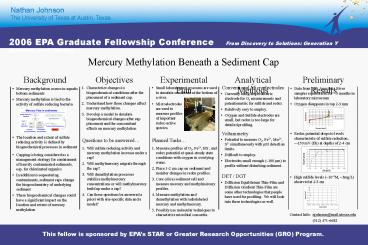Mercury methylation occurs in aquatic bottom sediments - PowerPoint PPT Presentation
1 / 1
Title:
Mercury methylation occurs in aquatic bottom sediments
Description:
2006 EPA Graduate Fellowship Conference From Discovery to Solutions: Generation ... changes after cap placement and the concomitant effects on mercury methylation ... – PowerPoint PPT presentation
Number of Views:76
Avg rating:3.0/5.0
Title: Mercury methylation occurs in aquatic bottom sediments
1
Nathan Johnson The University of Texas at Austin,
Texas
Mercury Methylation Beneath a Sediment Cap
Background
Objectives
Experimental Plan
Analytical Methods
Preliminary Results
Conventional Microelectrodes
- Characterize changes in biogeochemical conditions
after the placement of a sediment cap. - Understand how those changes affect mercury
methylation. - Develop a model to simulate biogeochemical
changes after cap placement and the concomitant
effects on mercury methylation
- Small laboratory microcosms are used to simulate
conditions at the bottom of a river.
- Data from bulk Anacostia River samples
equilibrated for gt3 months in laboratory
microcosm - Oxygen disappears in top 2-3 mm
- Mercury methylation occurs in aquatic bottom
sediments - Mercury methylation is tied to the activity of
sulfate reducing bacteria
- Currently using amperometric electrode for O2
measurements and potentiometric for sulfide and
redox - Relatively easy to employ.
- Oxygen and Sulfide electrodes are small, but
redox is too large for detailed profiling.
- Microelectrodes are used to measure profiles of
important redox-active species.
Voltammetry
- Redox potential drops to levels characteristic of
sulfate reduction, -150 mV (Eh) at depths
of 2-4 cm
- The location and extent of sulfate reducing
activity is defined by biogeochemical processes
in sediment
Questions to be answered
- Potential to measure O2, Fe2, Mn2, S2-
simultaneously with µM detection limits. - Difficult to employ.
- Electrodes small enough (100 µm) to profile
without disturbing sediment.
Planned Tasks
- Will sulfate reducing activity and mercury
methylation increase under a cap? - Will methylmercury migrate through the cap?
- Will demethylation processes stabilize
methylmercury concentrations or will
methylmercury build up under a cap? - Can these questions be answered a priori with
site-specific data and a model?
- Measure profiles of O2, Fe2, HS-, and redox
potential at quasi-steady state conditions with
oxygen in overlying water. - Place 1-2 cm cap on sediment and monitor changes
in redox profiles. - Core (slice) sediment cell and measure mercury
and methylmercury profiles. - Measure methylation and demethylation with
radiolabeled mercury and methylmercury. - Possibly use molecular techniques to characterize
microbial consortia.
- Capping is being considered as a management
strategy for containment of heavily contaminated
sediments, esp. for chlorinated organics - In addition to sequestering contaminants,
sediment caps change the biogeochemistry of
underlying sediment - These biogeochemical changes could have a
significant impact on the location and extent of
mercury methylation
DET / DGT
- High sulfide levels (10-4M, 3mg/L) observed at
2-3 cm
- Diffusion Equilibrium Thin-Film and Diffusion
Gradient Thin-Film are some other technologies
that people have used for profiling. We will
look into these technologies as well.
Contact Info njohnson_at_mail.utexas.edu (512)
471-6682

